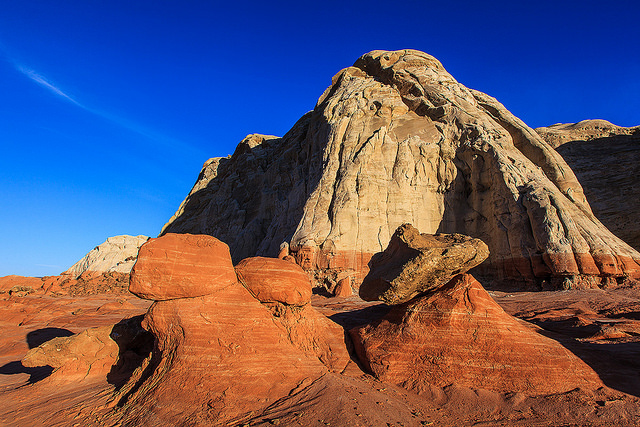The BLM is taking advantage of the reduction of the Grand Staircase-Escalante National Monument to draft a management plan that hands the spectacular Escalante Canyons over to livestock. Their plan, heavily influenced by politicians and ranchers, opens up areas that had been retired and recovering from grazing for decades. Backpackers who seek stunning recreational experiences in popular backcountry spots like the Gulch, Boulder Creek, and Death Hollow may now have to navigate dead livestock, get water from cattle-fouled springs, and set up their tents among cow pies. A few months of heavy grazing is likely to eliminate decades of ecological recovery in one or two seasons.
It’s critical that we call and write the BLM before November 30th to tell them why they should keep cattle out of the Escalante Canyons. Comment online at:https://tinyurl.com/ycl9supe. (You don’t have to fill out the part about title/chapter/section but it’s Vol. 1 p. 2-22). Or call and write to Matt Betenson at GSENM, 669 S Hwy 89A, Kanab, UT 84741 (435-644-1205).
Additional points to add:
- The BLM should choose the “No Action” alternative that would retain all allotment closures.
- Riparian (streamside) areas are critical wildlife habitat, especially in a desert. The plan should follow the mission of the National Landscape Conservation System and manage for natural resources.
- The Escalante Canyons are cherished by hikers and backpackers the world over. Their best use is for recreation, not cattle grazing.
- The BLM should not undo the recovery efforts of the Escalante River Partnership and waste nine years, ten million dollars, and the efforts of hundreds of volunteers.
Background (written by Jim Catlin – Sierra Club Utah)
* Cattle grazing impacts riparian areas far more than upland habitat. Riparian areas have the best forage and water, so cattle linger until the forage is largely gone. Such grazing can lead to camping areas in the canyons resembling a cattle feedlot.
* Decades ago, BLM retired grazing in the Escalante River canyons. Willing ranchers accepted payment from the Grand Canyon Trust to retire grazing in 59,000 acres in the Escalante River canyons, roughly 3% of the monument. This retirement was supported by the governor and the Utah Division of Wildlife Resources, which wrote that “Riparian habitats are highly valued for wildlife, even more so in arid regions such as the GSENM. The greatest diversity and abundance of species are found in riparian zones. Healthy and abundant streamside and floodplain vegetation benefits fisheries and water quality by providing cover and food resources, regulating water temperature, filtering and trapping sediments and nutrients, and increasing water storage for release over longer periods. . . . Moreover, upland grasses, forbs, and vegetative cover would increase and provide additional forage and cover for mule deer, desert bighorn sheep, rabbits, and other small mammals, which are in turn prey species for predators such as mountain lions, bobcats, coyotes, foxes, and raptors. In addition to benefiting wildlife, increasing vegetative cover can improve watershed quality, reduce soil erosion, allow better infiltration of precipitation into the soil, and enhance recreational and aesthetic values.”
* BLM itself gave these reasons for eliminating grazing decades ago: “The primary reason for closure was to eliminate resource use conflicts between recreational users and livestock. The Escalante and its tributary canyons receive very high use from both day and overnight hikers. The canyon bottom areas are primary travel routes and use areas. The closures also benefited riparian and upland vegetation, water quality and wildlife dependent on available forage. In the years since these closures, recreational use has continued to increase substantially and riparian vegetation has noticeably increased.”
* BLM’s new recommendation may cause negative economic impacts. The local economy has shifted from an agricultural economy to one based on tourism, recreation, and the retirement sector. These jobs now represent roughly 84% of the workforce in the two counties that include the Grand Staircase-Escalante National Monument. Agriculture, of which ranching is a smaller part, represents 6% of total employment. Protecting those lands that support the core economy is important and represents a small impact to the total grazing use of the Monument.
* In the past decade, nearly a thousand volunteers and conservation workers have been working to remove Russian olive tree from these canyons. The result has been a remarkable recovery of native cottonwood trees, willows, and grasses and forbs. With this recovery, the wildlife is rebounding. BLM’s plan to bring grazing to these canyons would undo this ecological recovery.







